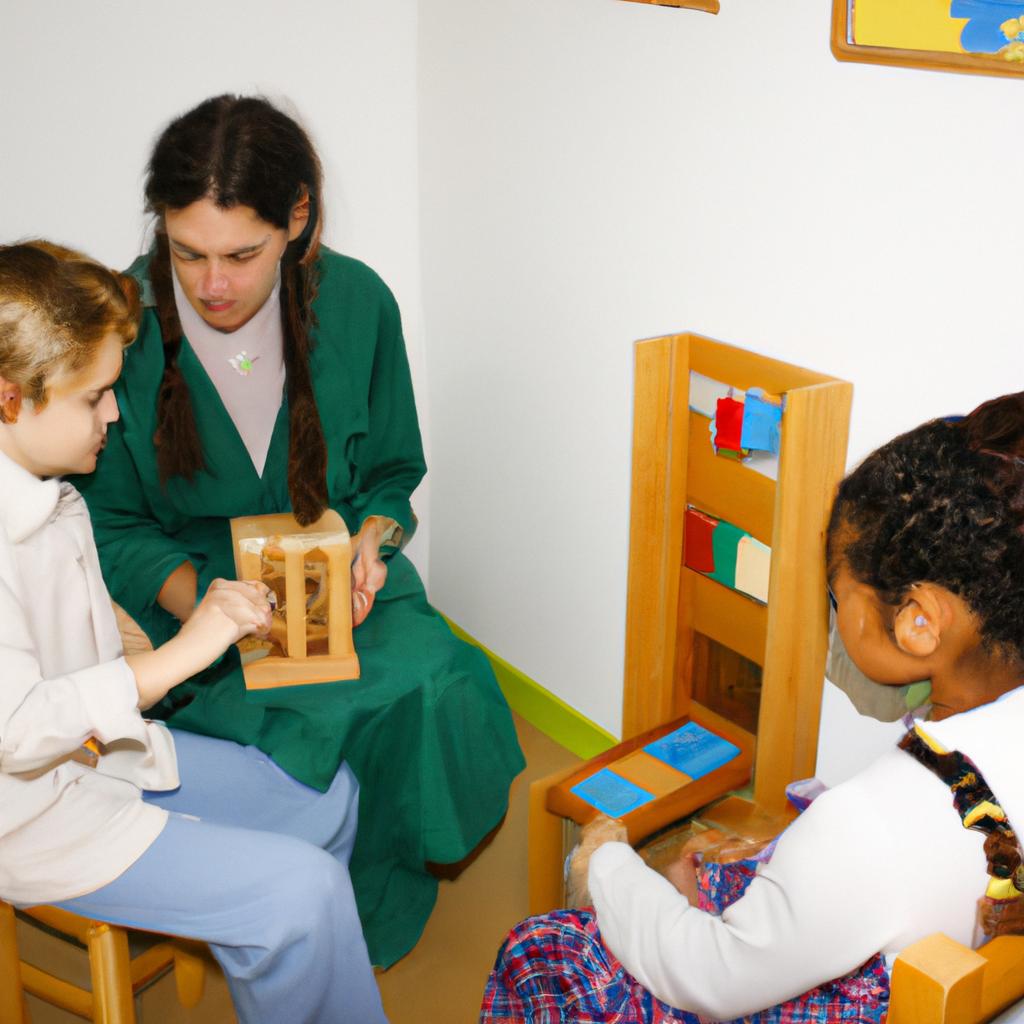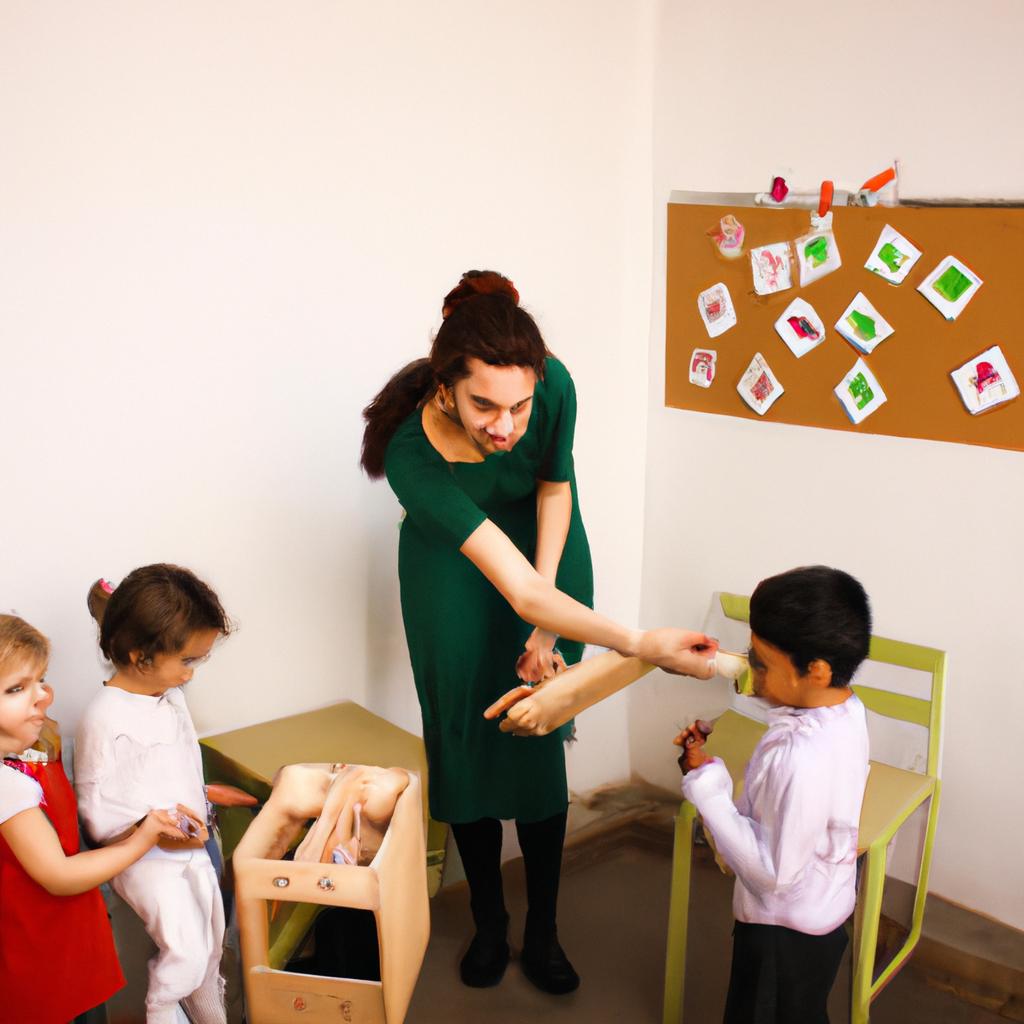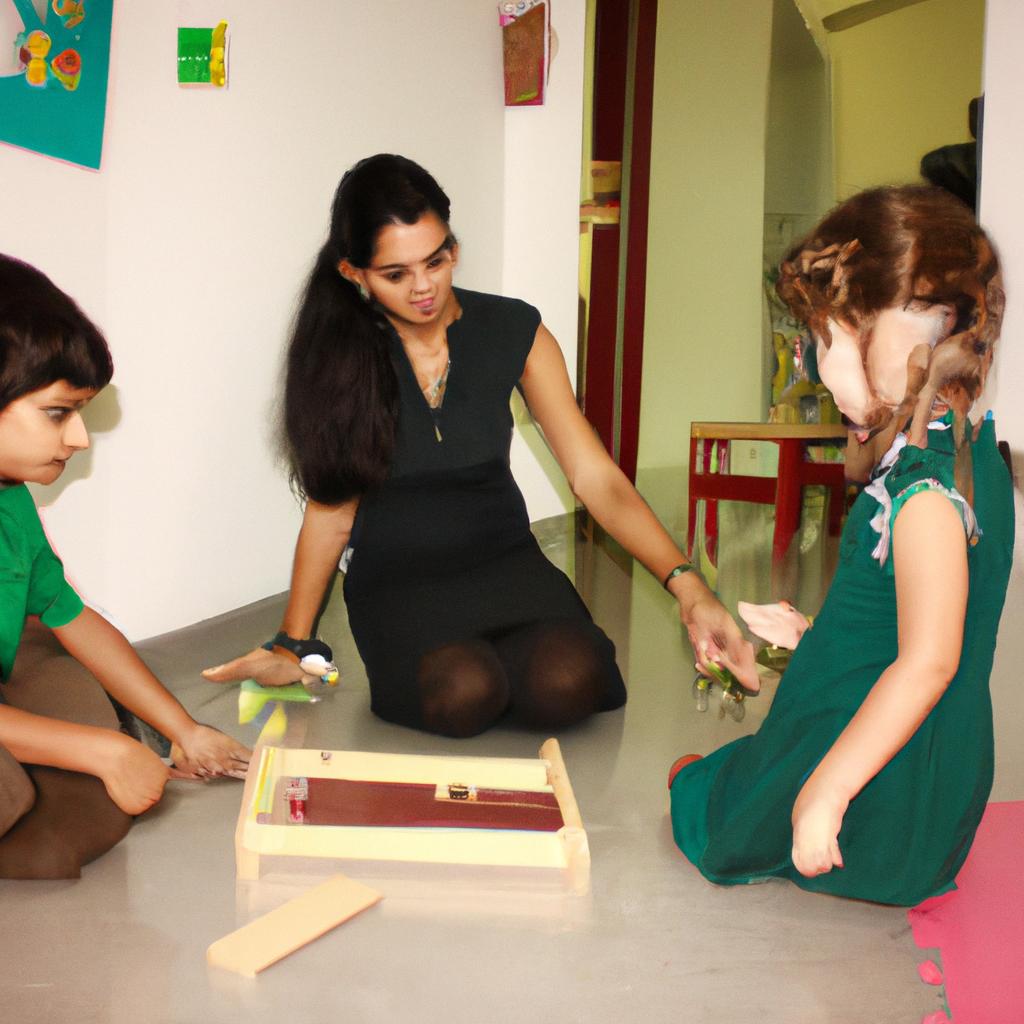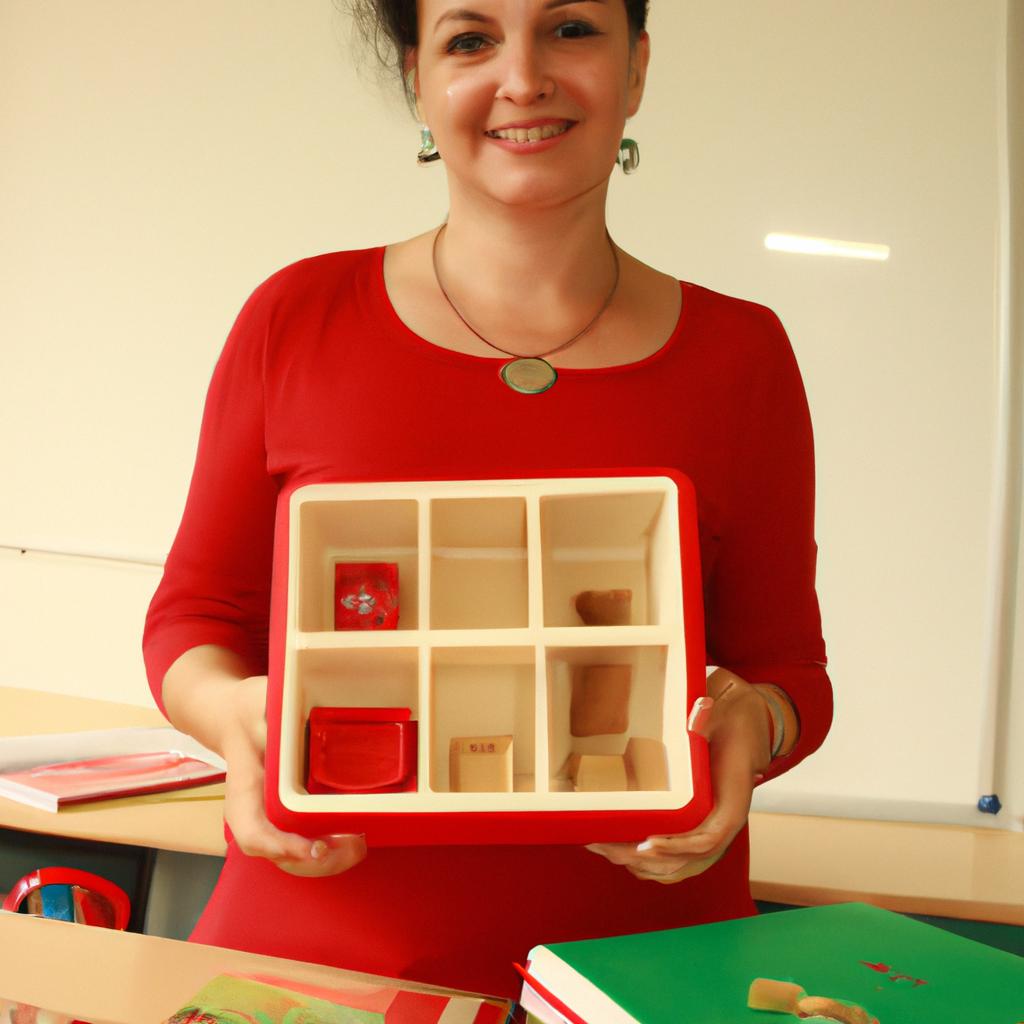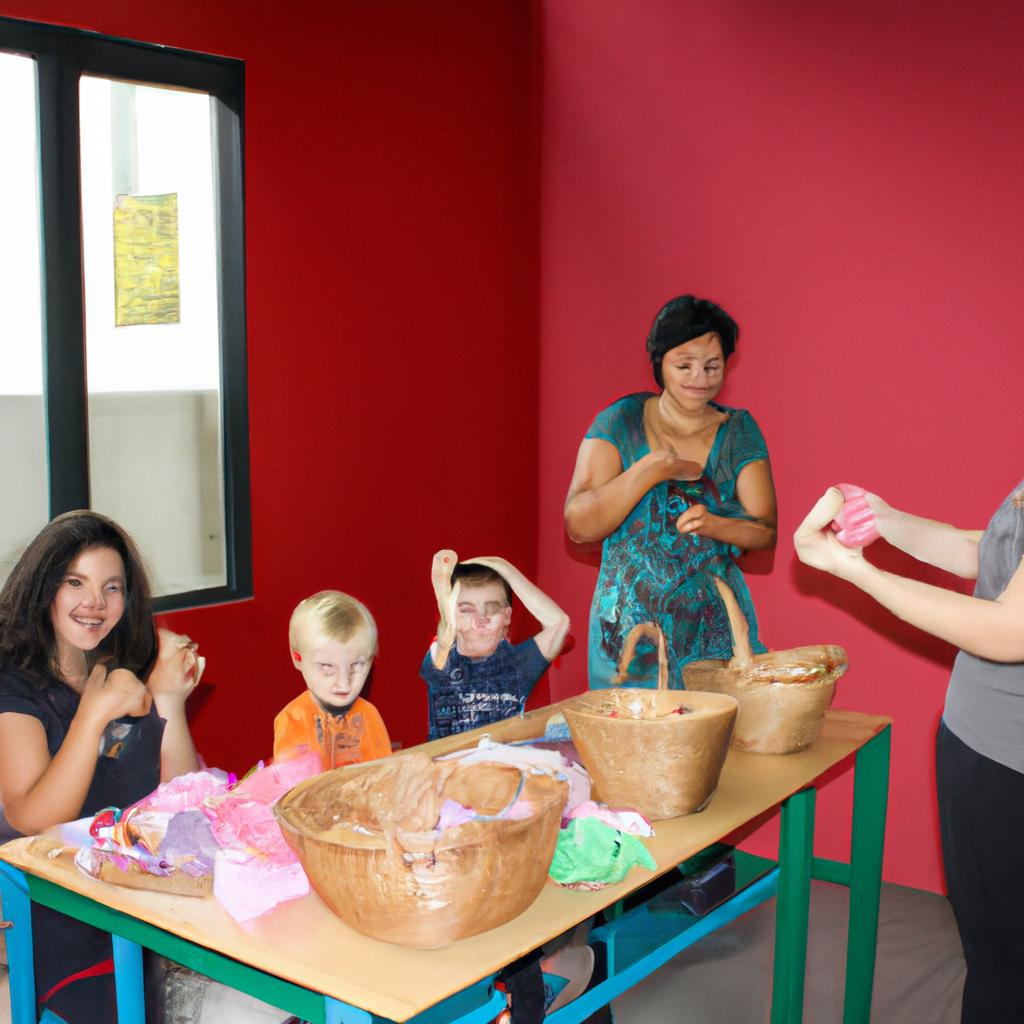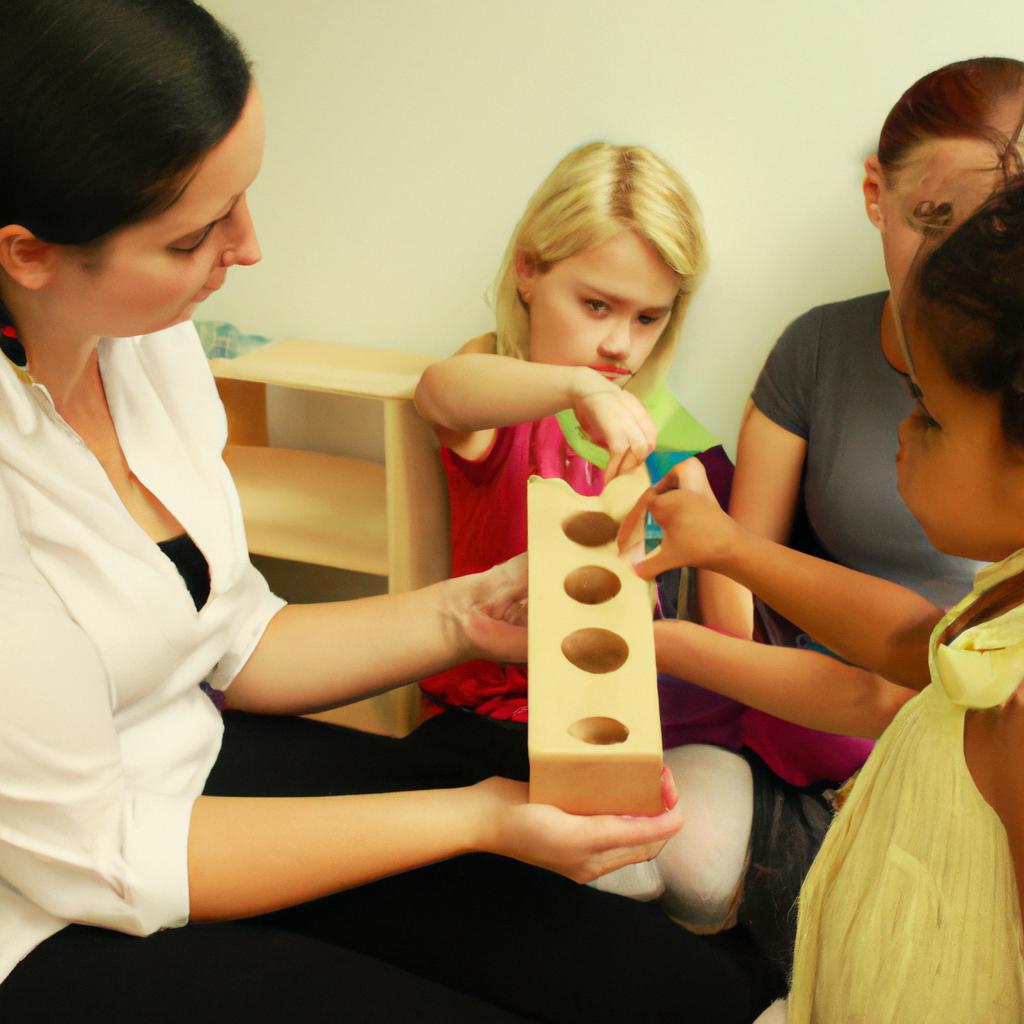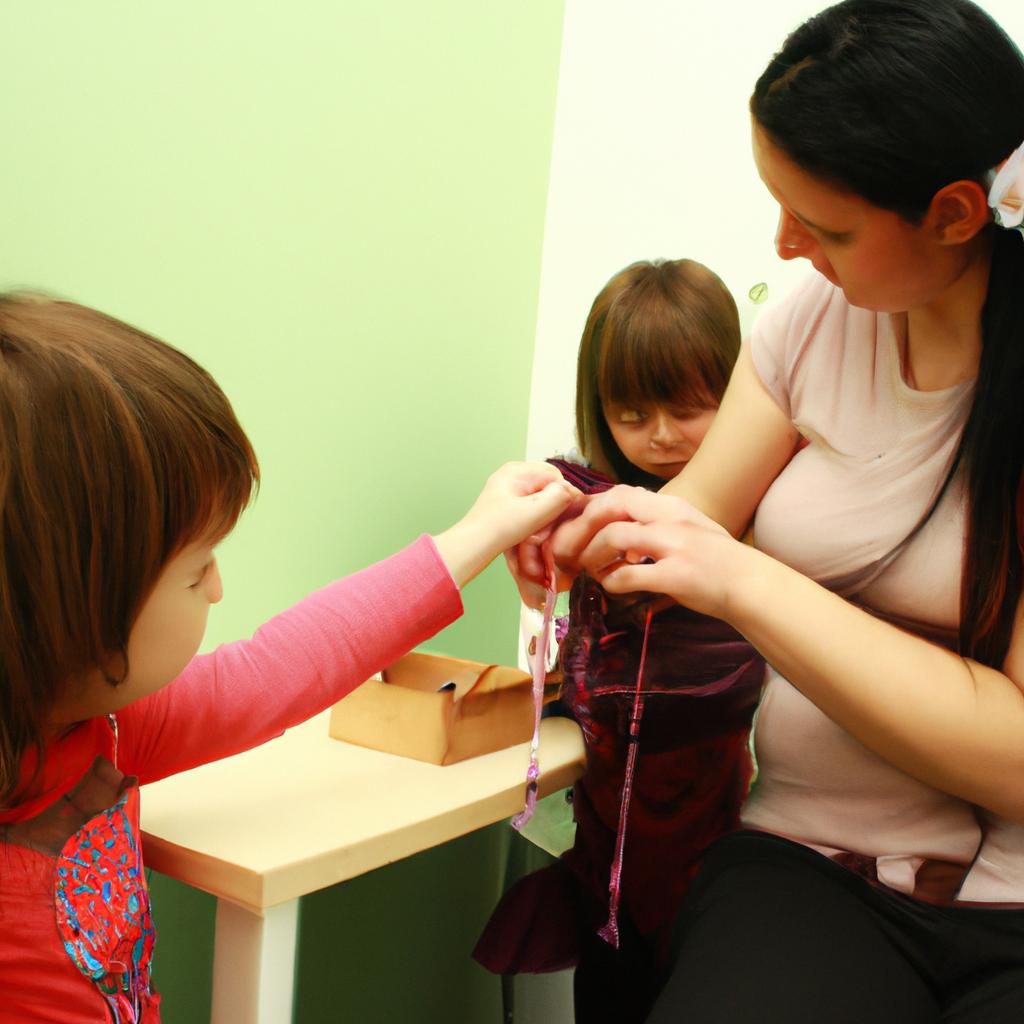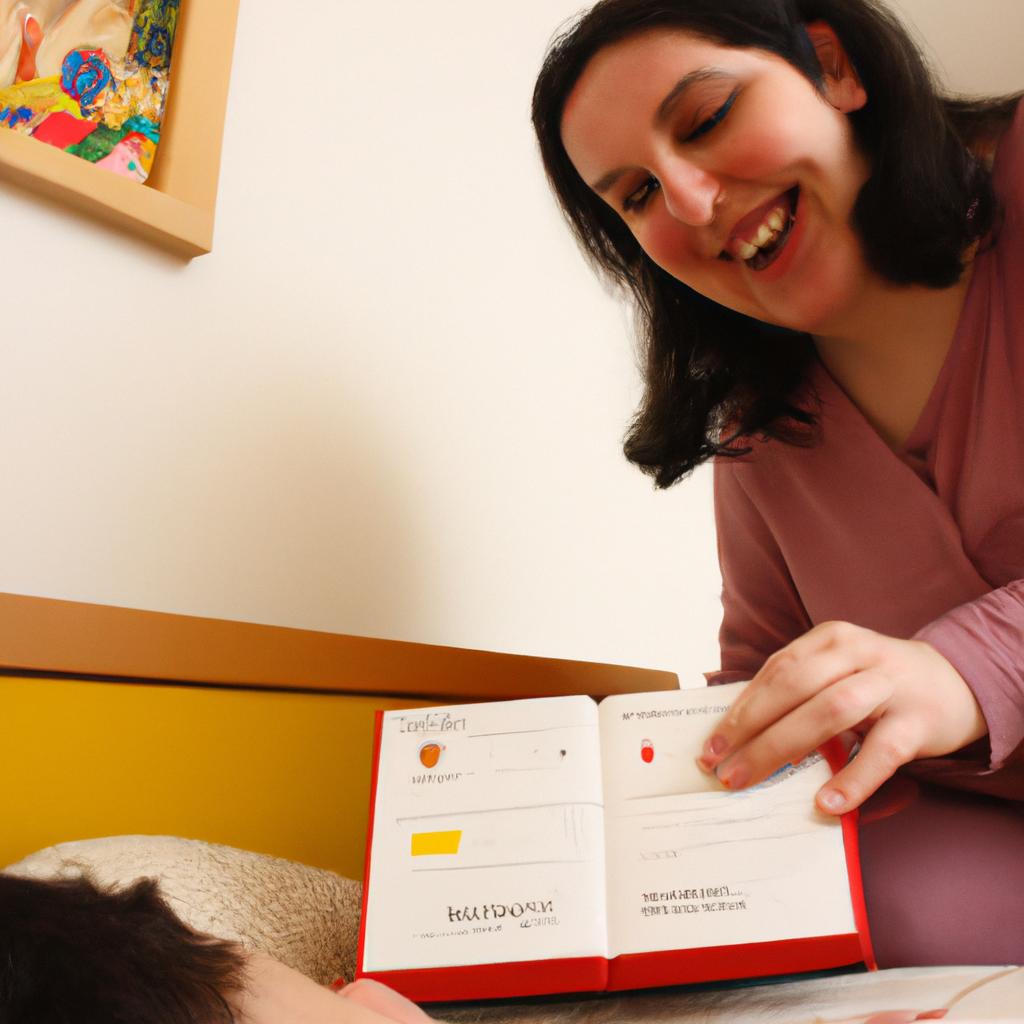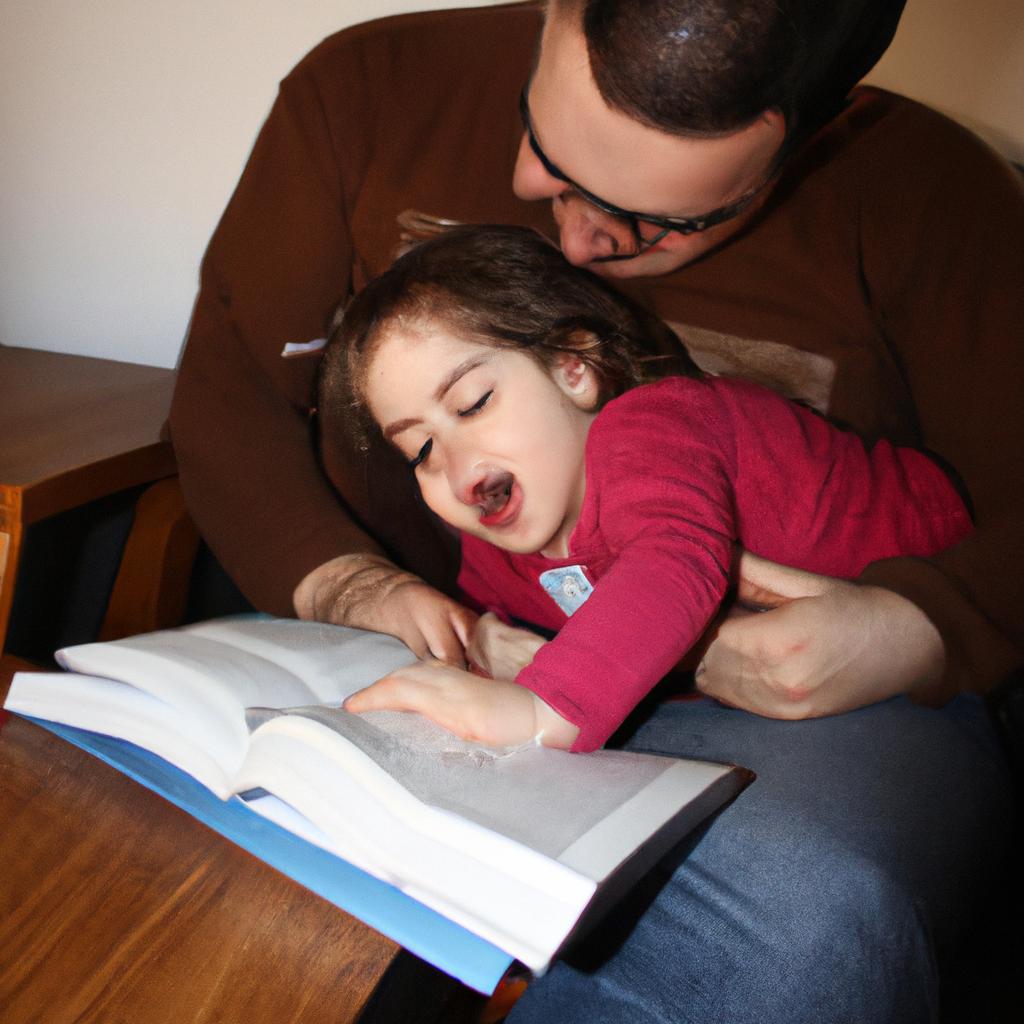In the field of education, the Montessori method has gained recognition for its unique approach to teaching and learning. Central to this pedagogical approach is the role of the Montessori teacher, who plays a pivotal role in facilitating the educational experience for students. One example that exemplifies the significance of the Montessori teacher’s role in lesson planning can be seen through a hypothetical scenario involving a primary classroom. In this case, a group of five-year-old children are engaged in an activity exploring geometric shapes. The Montessori teacher carefully plans and prepares materials that provide opportunities for hands-on exploration and discovery, ensuring that each child’s individual needs and interests are catered to.
Within the context of Montessori education, lesson planning holds crucial importance as it serves as a roadmap for teachers to guide their instructional practices effectively. As educators embrace Maria Montessori’s belief in following the child’s natural development, lesson planning becomes more than just organizing activities; it becomes an intentional process tailored to meet each student’s unique learning requirements. By thoughtfully designing lessons based on observations and assessments, Montessori teachers create an environment where learners can explore concepts at their own pace while fostering independence and self-motivation.
Moreover, effective lesson planning enables Mont Moreover, effective lesson planning enables Montessori teachers to create a well-balanced curriculum that covers a wide range of subjects and promotes the holistic development of students. By carefully sequencing activities and materials, teachers can provide a coherent and comprehensive learning experience that integrates various disciplines such as language, mathematics, science, cultural studies, and practical life skills.
In addition to promoting academic growth, lesson planning in Montessori education also emphasizes the social-emotional development of students. Teachers incorporate opportunities for collaboration, problem-solving, and conflict resolution within their lessons to foster positive relationships among peers and develop essential life skills.
Furthermore, through intentional lesson planning, Montessori teachers ensure that they are meeting the individual needs of each student. They consider factors such as learning styles, interests, abilities, and challenges when designing lessons. This personalized approach allows for differentiated instruction and helps create an inclusive classroom environment where all students feel valued and supported in their learning journey.
Overall, lesson planning plays a vital role in the Montessori method by providing structure, guidance, and flexibility to teachers as they facilitate learning experiences for their students. It enables educators to create an engaging and purposeful educational environment that nurtures curiosity, independence, creativity, critical thinking skills while fostering a love for lifelong learning.
Understanding the Montessori Method
The Montessori method of education, developed by Dr. Maria Montessori in the early 20th century, is a child-centered approach that emphasizes independence, freedom within limits, and respect for a child’s natural psychological development. In this section, we will explore the key principles of the Montessori method and their implications for lesson planning.
One example that illustrates the effectiveness of the Montessori method is Sarah, a four-year-old student who struggled with focus and concentration in a traditional classroom setting. When introduced to the Montessori approach, Sarah thrived in an environment where she could choose her own activities and work at her own pace. Through hands-on learning experiences and individualized instruction, she developed self-discipline and became more engaged in her studies.
To gain a deeper understanding of how the Montessori method promotes holistic development, consider these key elements:
- Prepared Environment: The classroom is carefully designed to foster independent learning and exploration. Materials are arranged on low shelves so children can access them easily. A calm atmosphere encourages concentration while providing opportunities for movement.
- Mixed-Age Groupings: Children of different ages learn together in multi-age classrooms. This social dynamic allows younger students to learn from older peers while older students reinforce their knowledge by teaching others.
- Self-Correction: Montessori materials are designed with built-in feedback mechanisms that enable children to independently identify mistakes or errors as they engage with various concepts.
- Individualized Instruction: Teachers observe each child closely to understand their unique needs and interests. Lessons are tailored accordingly, ensuring that every student receives appropriate challenges and support.
Embracing these principles requires thoughtful lesson planning that aligns with the developmental stages of each child. By incorporating engaging activities into daily plans, teachers create an environment conducive to active learning and discovery.
Transitioning into our discussion about the importance of lesson planning, it becomes evident that effective preparation plays a crucial role in maximizing the potential of the Montessori method. By carefully designing lessons that meet individual needs and align with curricular goals, teachers can facilitate meaningful learning experiences for their students.
Importance of Lesson Planning
Understanding the Montessori Method is essential in order to comprehend the role of a Montessori teacher and their approach to lesson planning. By embracing the principles established by Maria Montessori, teachers can create an environment that fosters independence, self-discipline, and a love for learning among students. This section will delve into the intricacies of the Montessori teacher’s responsibilities when it comes to lesson planning.
To illustrate this point, consider a hypothetical scenario where a Montessori teacher is preparing a language lesson for her class. She begins by carefully observing each student’s progress and identifying their individual needs and interests. Using this information as a guide, she designs activities that cater to different learning styles and levels of proficiency within the classroom.
When developing lessons in line with the Montessori philosophy, teachers prioritize certain key aspects:
- Individualization: The teacher recognizes that every child has unique strengths, challenges, and preferences. They tailor their lessons accordingly to ensure maximum engagement and growth for each student.
- Hands-on Learning: A cornerstone of the method involves providing concrete experiences through manipulative materials that enable children to learn through touch, movement, and exploration.
- Freedom within Limits: Teachers foster independence by allowing students freedom of choice within clear boundaries defined by age-appropriate material options available in carefully prepared environments.
- Respectful Guidance: Rather than dictating knowledge or imposing strict rules, Montessori teachers act as guides who gently direct students towards discovering concepts on their own.
A table highlighting these fundamental principles may further emphasize their significance:
| Principles | Description |
|---|---|
| Individualization | Recognizing each child’s unique needs and tailoring lessons accordingly |
| Hands-on Learning | Providing concrete experiences through manipulative materials |
| Freedom within Limits | Allowing freedom of choice within clearly defined boundaries |
| Respectful Guidance | Acting as gentle guides to help students discover concepts on their own |
By adhering to these principles, Montessori teachers create a nurturing environment that inspires curiosity and fosters a love for learning.
With a solid foundation in the Montessori Method and an understanding of the key responsibilities involved in lesson planning, Montessori teachers can now focus on creating individualized lesson plans tailored to meet the unique needs of their students.
Creating Individualized Lesson Plans
The Importance of Lesson Planning in the Montessori Method cannot be overstated. By carefully designing and organizing lessons, Montessori teachers can create an environment that nurtures each child’s unique learning abilities and fosters their overall development. In this section, we will explore the crucial role of the Montessori teacher in lesson planning and how it contributes to a successful educational experience.
To illustrate this point, let’s consider a hypothetical example of a Montessori teacher named Ms. Johnson. She has a class with children at different levels of understanding mathematics concepts. Using her expertise in lesson planning, Ms. Johnson designs individualized activities for each student based on their specific needs and interests. For instance, she creates hands-on materials for one student who learns best through tactile experiences, while incorporating visual aids for another student who thrives in visually stimulating environments.
Effective lesson planning allows Montessori teachers like Ms. Johnson to cater to students’ diverse learning styles and preferences. Here are four ways in which they achieve this:
- Providing opportunities for kinesthetic learners to engage in physical activities or manipulative tasks.
- Incorporating visual elements such as charts, diagrams, or pictures to support visual learners.
- Utilizing auditory resources like music or recordings for students who learn best through listening.
- Offering various options for students to choose from when working on assignments or projects, allowing them autonomy over their learning process.
In addition to these strategies, Montessori teachers often utilize well-designed materials and tools during lessons. The following table illustrates some examples:
| Learning Style | Materials/Tools |
|---|---|
| Kinesthetic | Moveable objects (e.g., counting blocks) |
| Visual | Charts, graphs |
| Auditory | Audio recordings |
| Independent | Self-paced workbooks |
By employing these techniques and utilizing appropriate materials tailored to individual learning styles, Montessori teachers ensure that each student receives the support they need to thrive academically and personally.
As we have seen, lesson planning plays a vital role in promoting effective learning experiences within the Montessori Method. By individualizing lessons to accommodate different learning styles and utilizing suitable materials, Montessori teachers can create an inclusive and engaging environment for their students.
Adapting Lesson Plans for Different Learning Styles
Having discussed the process of creating individualized lesson plans, it is crucial for Montessori teachers to be able to adapt these plans to cater to different learning styles. By recognizing and understanding the unique needs and preferences of each student, teachers can ensure that their lessons are effective in promoting meaningful learning experiences.
To illustrate this point, let us consider a hypothetical case study involving two students with contrasting learning styles. Sarah, a visual learner, thrives when presented with information through images, diagrams, and videos. On the other hand, James, an auditory learner, absorbs knowledge best through listening and participating in discussions.
In order to accommodate both learners effectively, Montessori teachers employ various strategies:
- Visual aids: Utilizing visual aids such as charts, graphs, or drawings helps engage visual learners like Sarah by providing clear illustrations of concepts.
- Verbal explanations: For auditory learners like James, verbal explanations play a vital role. Teachers may use storytelling techniques or encourage group discussions to facilitate comprehension.
- Hands-on activities: Incorporating hands-on activities into lesson plans benefits kinesthetic learners who learn best through physical interaction and movement.
- Multisensory approach: By combining elements from all three types of learning styles – visual, auditory, and kinesthetic – Montessori teachers create well-rounded lesson plans that appeal to a broader range of students.
- Increased engagement and participation among students
- Enhanced motivation and enthusiasm towards learning
- Improved retention of information due to personalized instruction
- Boosted self-confidence in students as they experience success in their preferred style of learning
Catering to diverse learning styles not only fosters inclusivity within the classroom but also enhances overall academic performance. In our next section on “Incorporating Hands-on Materials and Activities,” we will explore how Montessori educators integrate tactile experiences into their lesson plans to provide students with a holistic learning environment.
Incorporating Hands-on Materials and Activities
In the previous section, we discussed the importance of adapting lesson plans to accommodate different learning styles. Now, let’s delve deeper into this topic by exploring how Montessori teachers can effectively plan their lessons to cater to diverse learners.
Imagine a classroom with students who have varying learning preferences and strengths. For instance, consider a hypothetical case study where Sarah struggles with auditory processing but excels in visual-spatial intelligence, while Michael is an avid kinesthetic learner. To ensure that both Sarah and Michael are actively engaged and able to comprehend the material being taught, the Montessori teacher must employ strategies that address their specific needs.
To adapt lesson plans for different learning styles, Montessori educators can incorporate various techniques:
- Visual aids: Utilizing charts, diagrams, or videos provides visual learners like Sarah with tangible representations of abstract concepts.
- Hands-on activities: Incorporating manipulatives or interactive tasks caters to kinesthetic learners such as Michael, allowing them to physically engage with the content.
- Verbal explanations: Auditory learners benefit from clear verbal instructions and discussions that allow them to process information through listening.
- Collaborative projects: Group work encourages social interaction and fosters cooperative learning among students with diverse learning styles.
Moreover, employing these adaptations not only benefits individual students but also enhances overall class engagement and participation. It creates an inclusive classroom environment where every student feels valued and supported in their unique learning journey.
| Learning Style | Characteristics | Strategies |
|---|---|---|
| Visual | Prefers visual aids | Use charts, diagrams, or videos |
| Spatial | Excels in visual-spatial tasks | Provide tangible representations |
| Kinesthetic | Learns best through physical movement | Incorporate hands-on activities |
| Auditory | Processes information through listening | Offer clear verbal explanations |
By incorporating these strategies and adapting lesson plans to cater to diverse learning styles, Montessori teachers can create an inclusive classroom environment that supports the individual needs of each student. In doing so, they foster a sense of belonging and ensure optimal engagement in the learning process.
Transitioning into the next section on “Assessing Student Progress,” it is crucial for Montessori educators to not only adapt their lesson plans but also continually evaluate how effectively these adaptations are meeting students’ needs. By assessing student progress, teachers can refine their teaching approaches and further tailor future lessons to maximize educational outcomes.
Assessing Student Progress
The Role of the Montessori Teacher: Lesson Planning
Incorporating Hands-on Materials and Activities
In the previous section, we discussed the importance of incorporating hands-on materials and activities in Montessori education. Now, let us explore how these elements are seamlessly integrated into lesson planning by Montessori teachers.
To illustrate this point, consider a case study involving Ms. Johnson, a Montessori teacher working with a group of 5-year-old students. For their math lesson on addition, she prepares an engaging activity using manipulative objects such as colored blocks. The students are encouraged to use these materials to physically represent numbers and perform simple calculations. By providing concrete tools for learning, Ms. Johnson not only enhances student engagement but also fosters conceptual understanding.
When designing lessons that incorporate hands-on materials and activities, Montessori teachers follow some key guidelines:
- Promote exploration and discovery: Teachers aim to create an environment where children can actively explore concepts through self-guided discovery rather than passive instruction.
- Foster independent thinking: Lessons encourage critical thinking skills by presenting open-ended problems or questions that require creative solutions.
- Encourage collaboration: Students often work collaboratively during hands-on activities, promoting social interaction and cooperative problem-solving.
- Adapt to individual needs: Teachers tailor lessons according to each child’s unique abilities and interests, ensuring differentiated instruction within the classroom.
These strategies align with Maria Montessori’s belief that children learn best when they are actively engaged in meaningful experiences. By integrating hands-on materials and activities into lesson planning, teachers provide opportunities for holistic development across various domains – cognitive, physical, emotional, and social.
By employing techniques like those mentioned above, Montessori educators effectively engage learners while nurturing their innate curiosity and love for lifelong learning.


